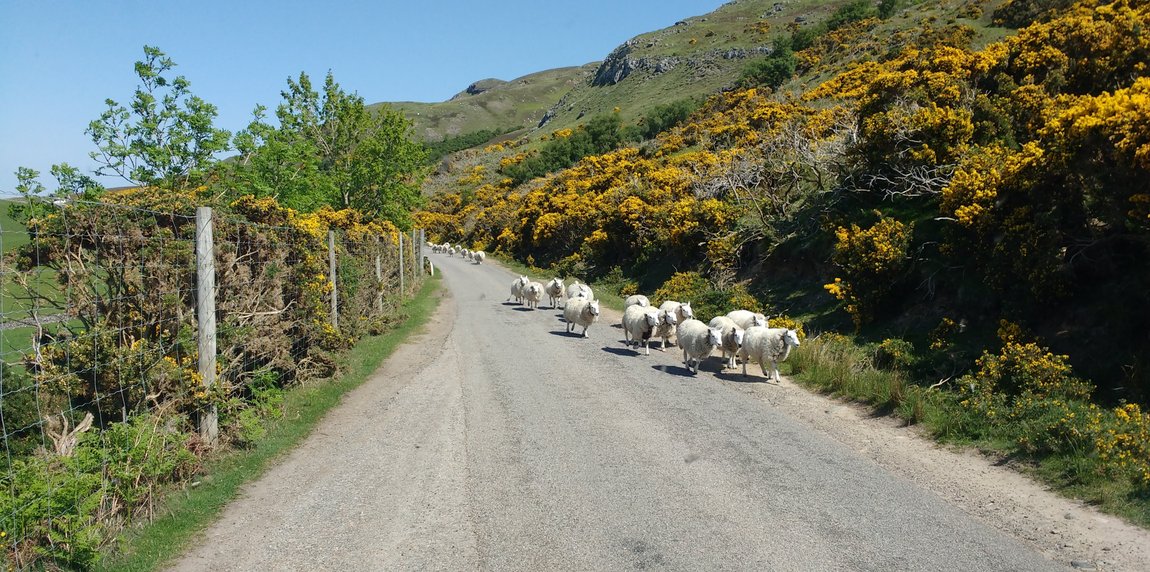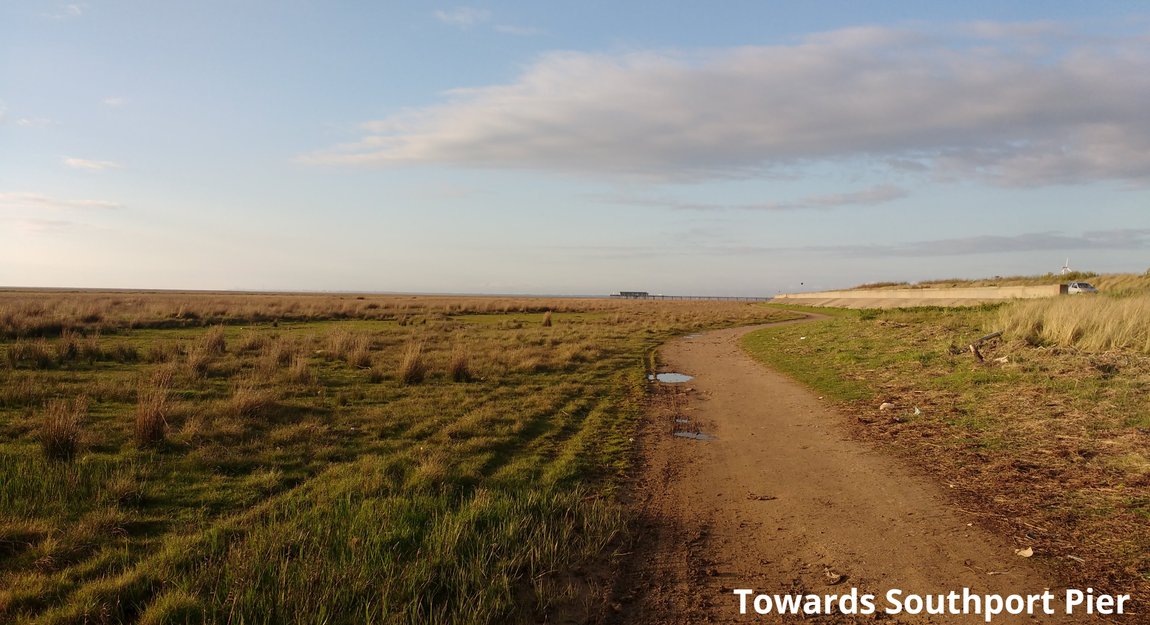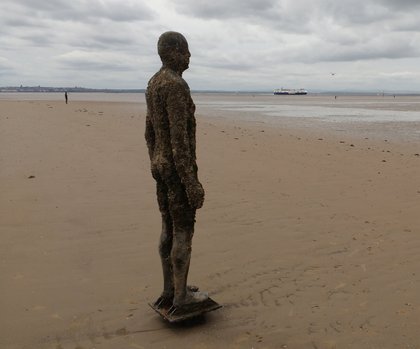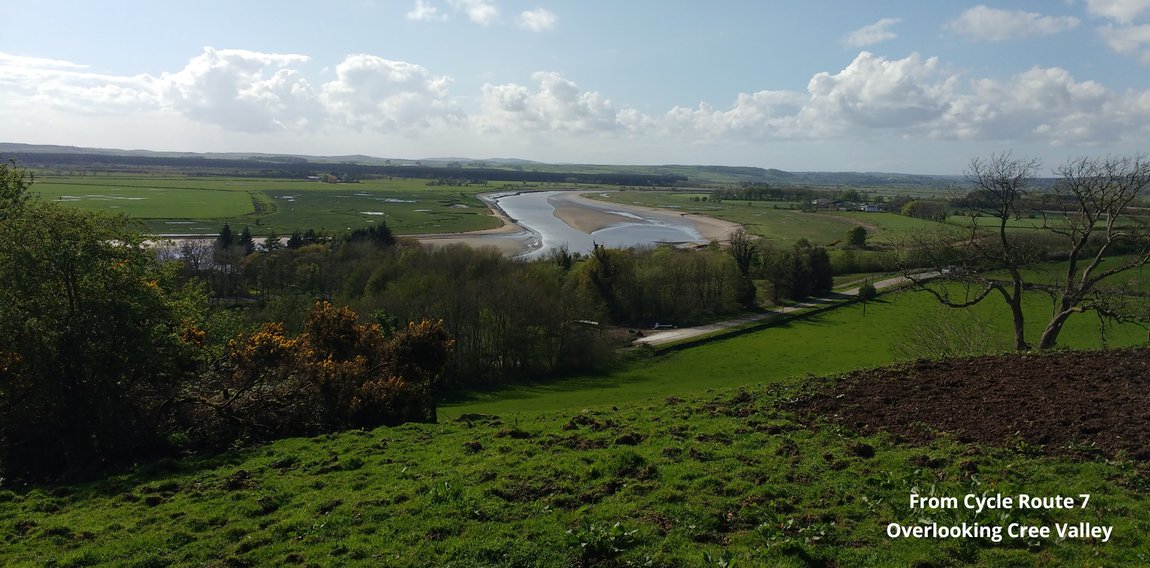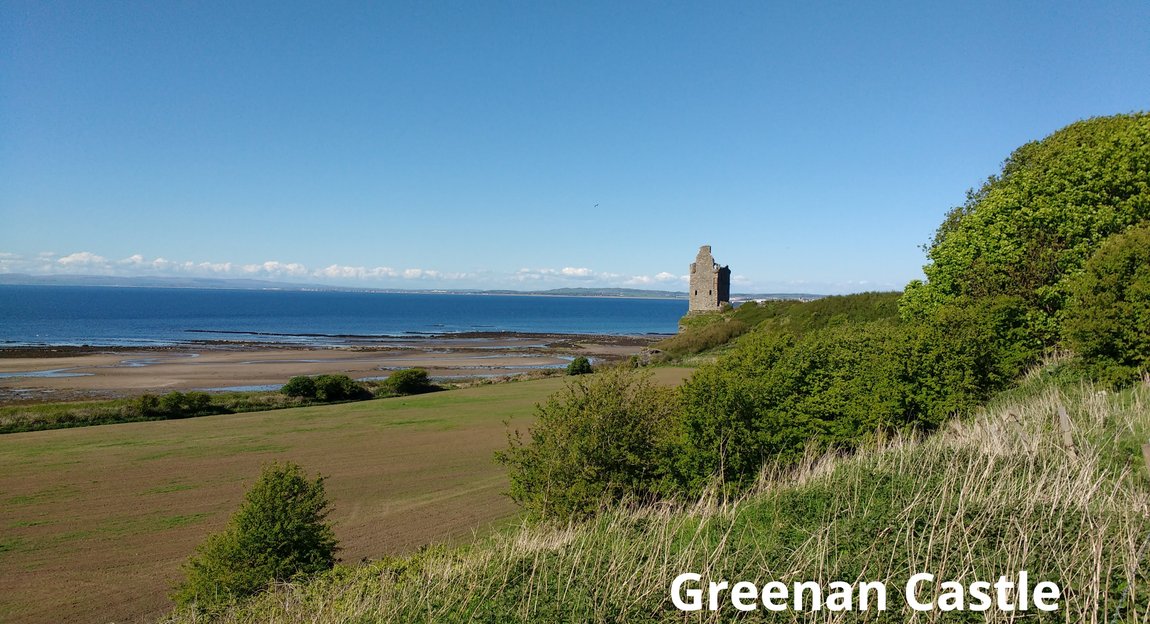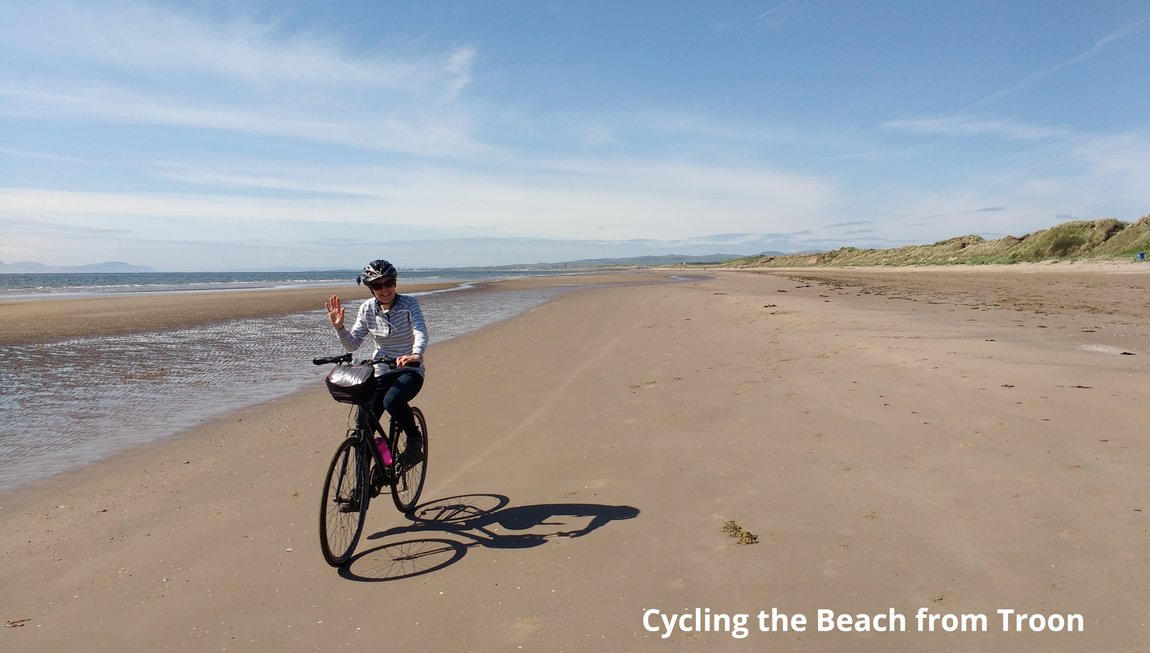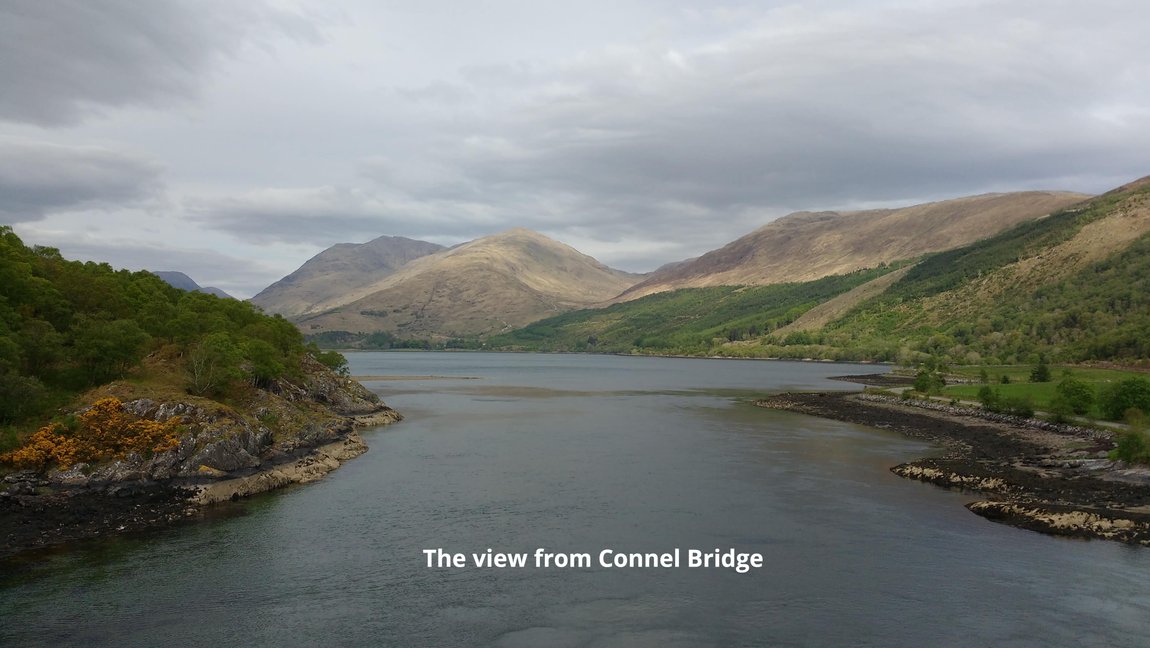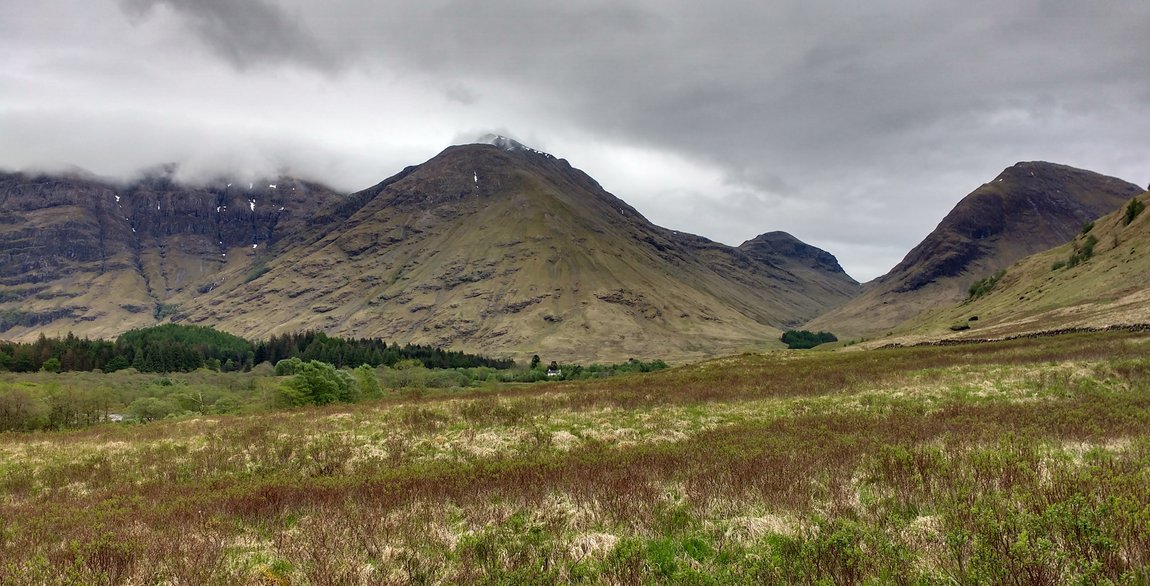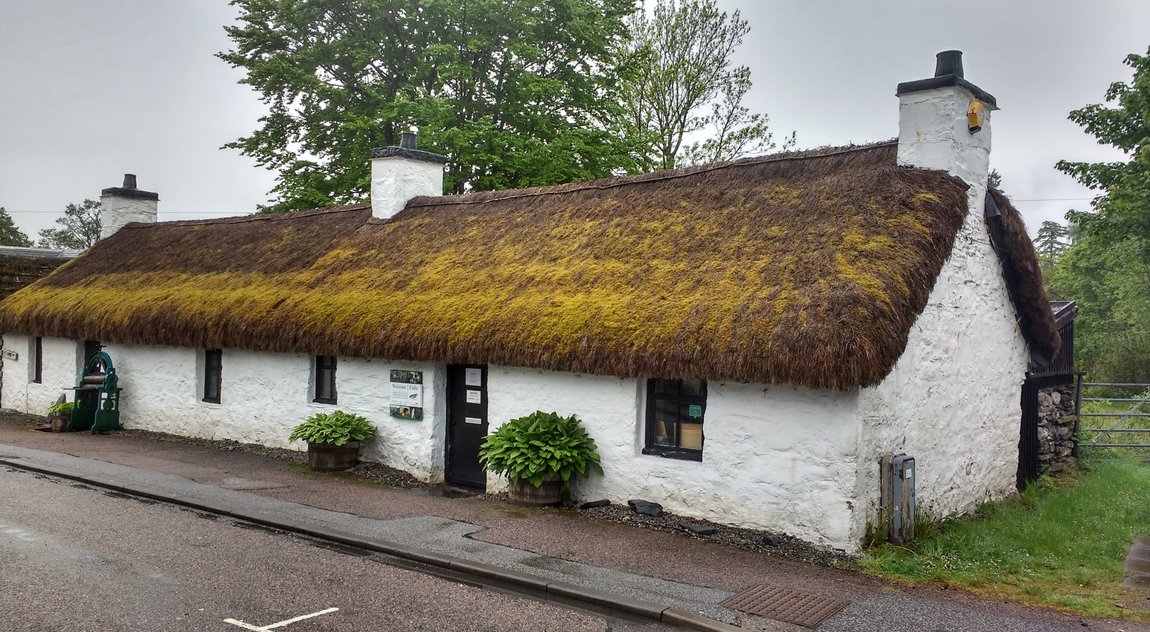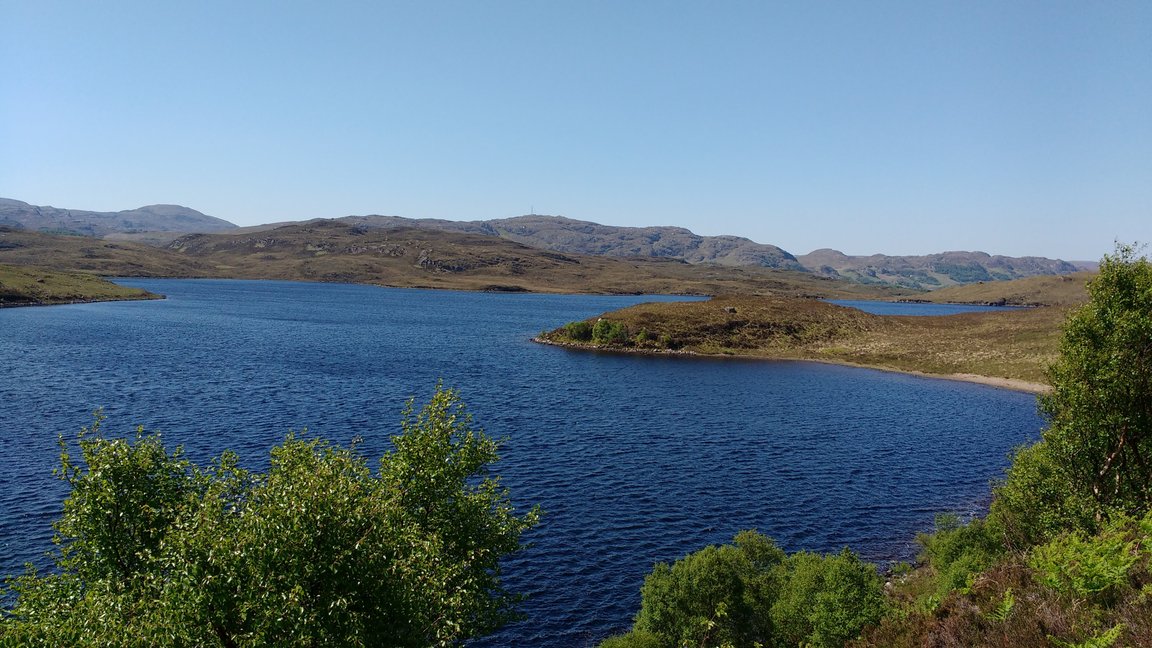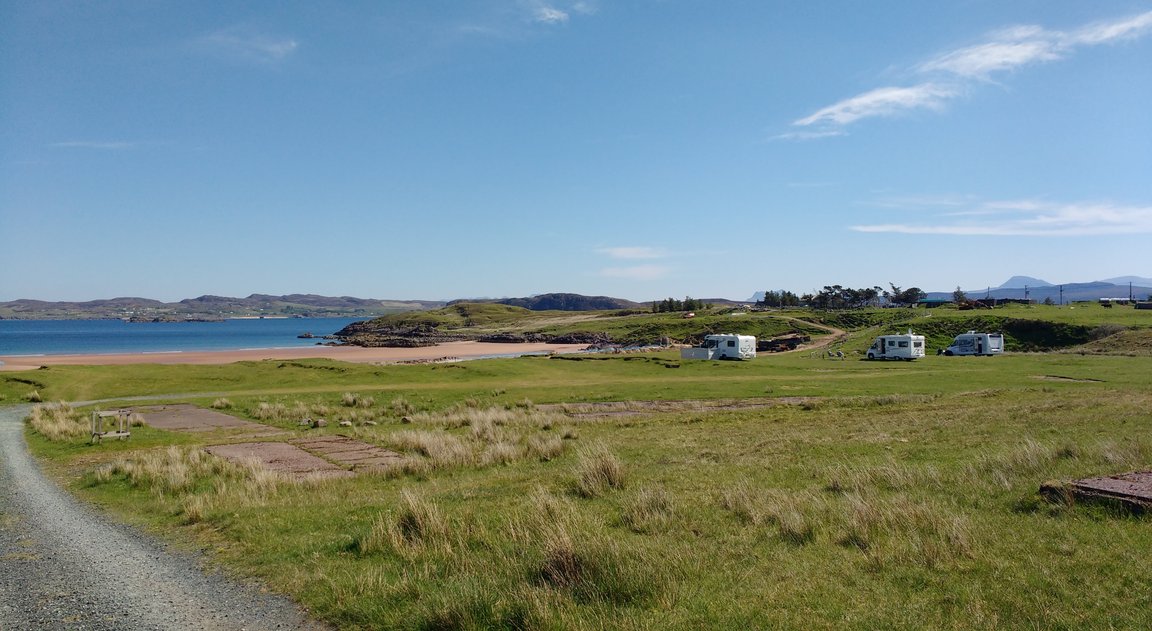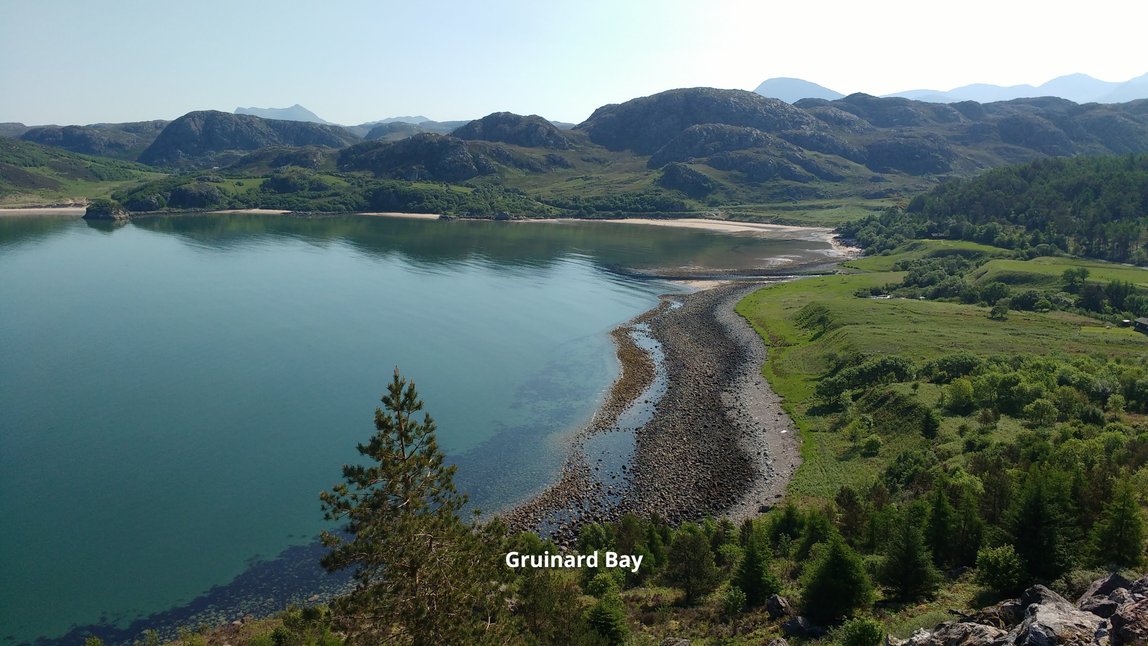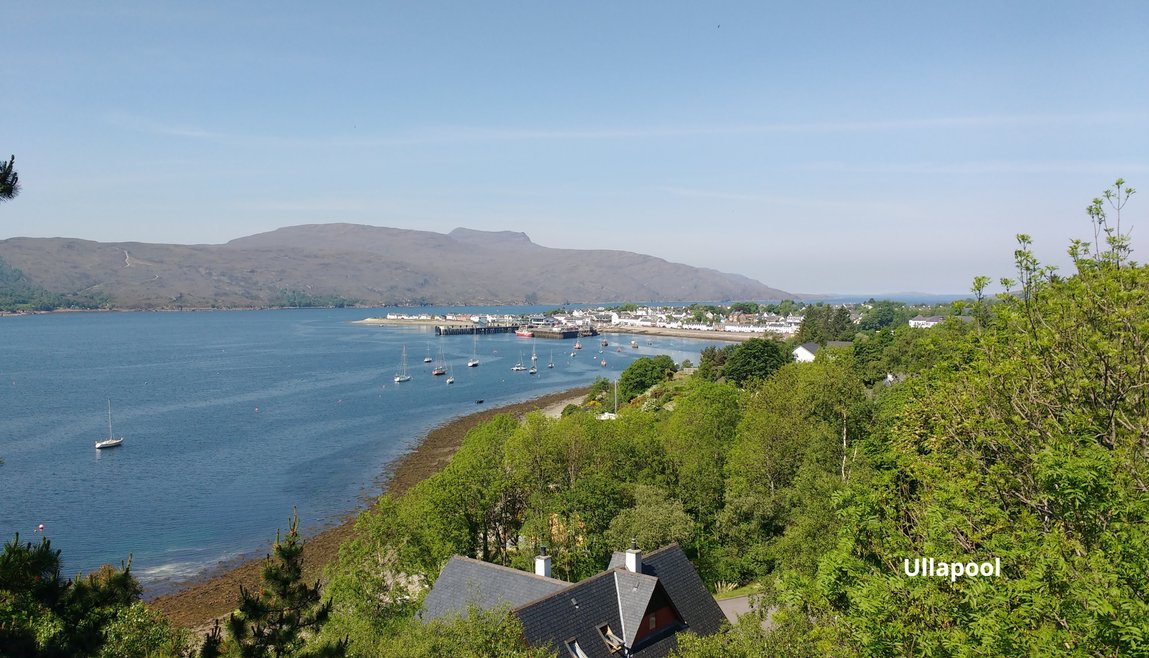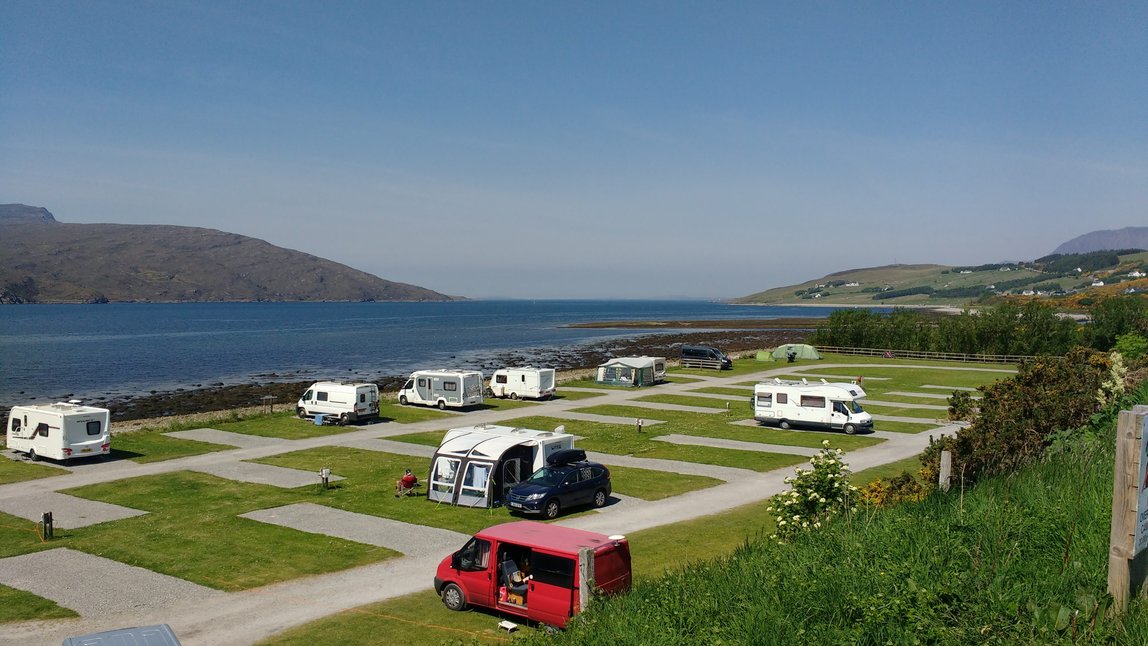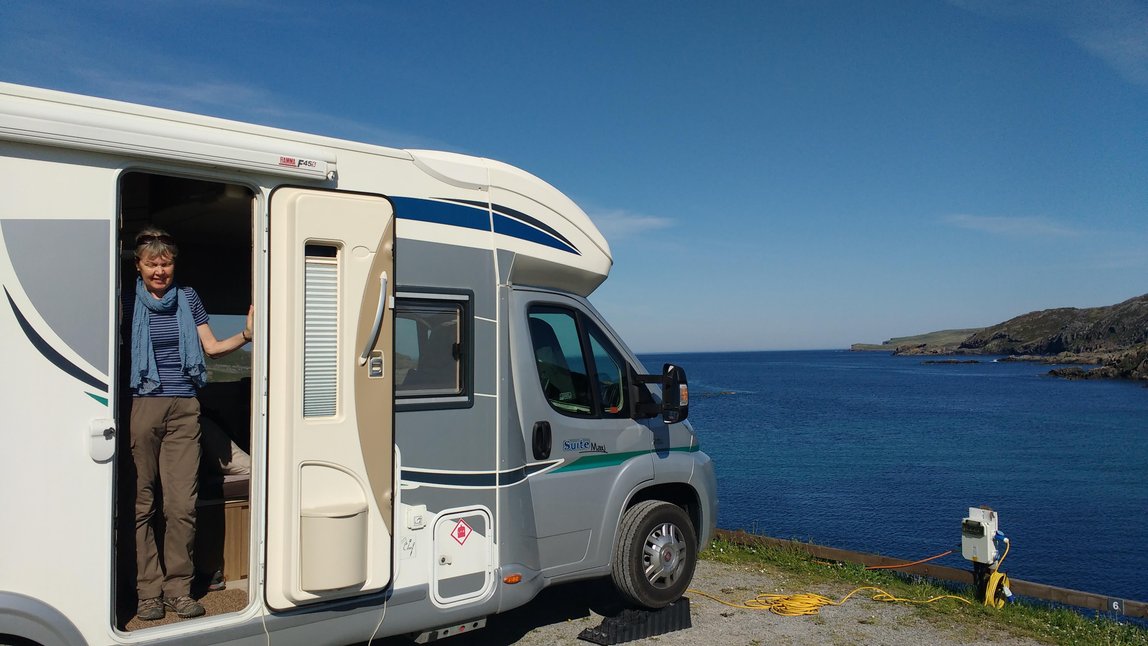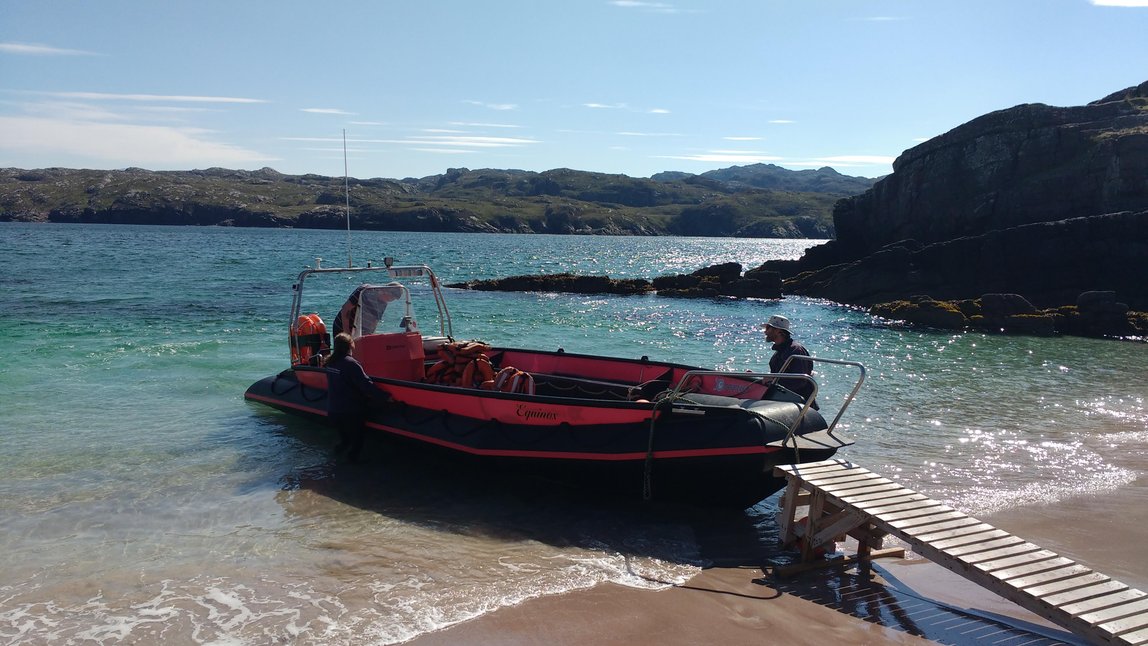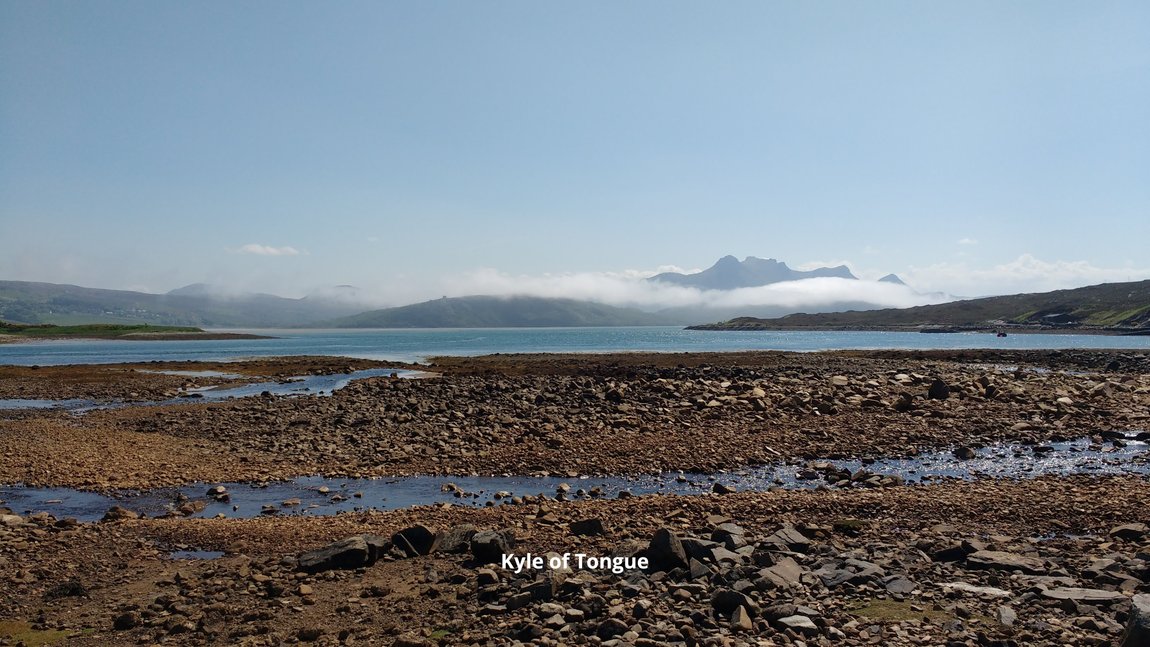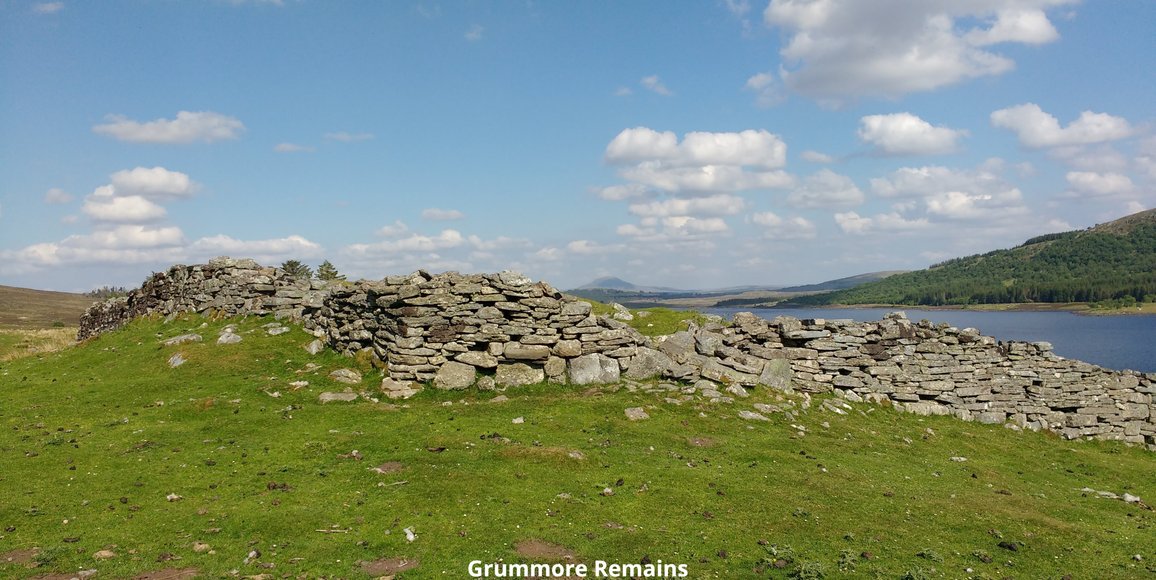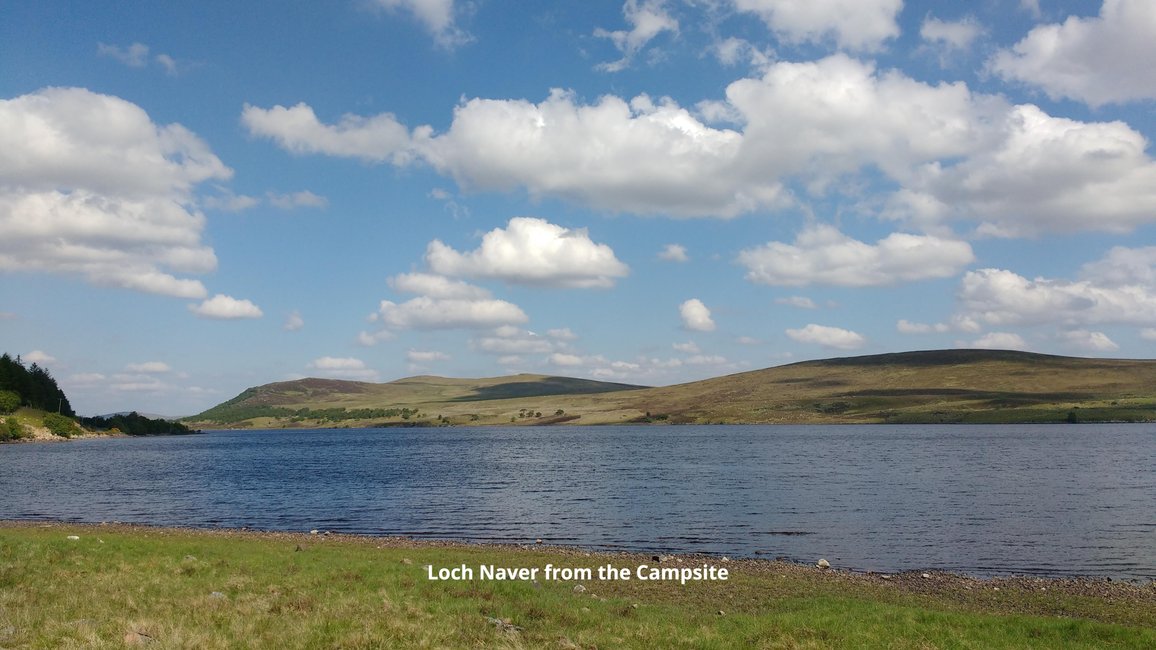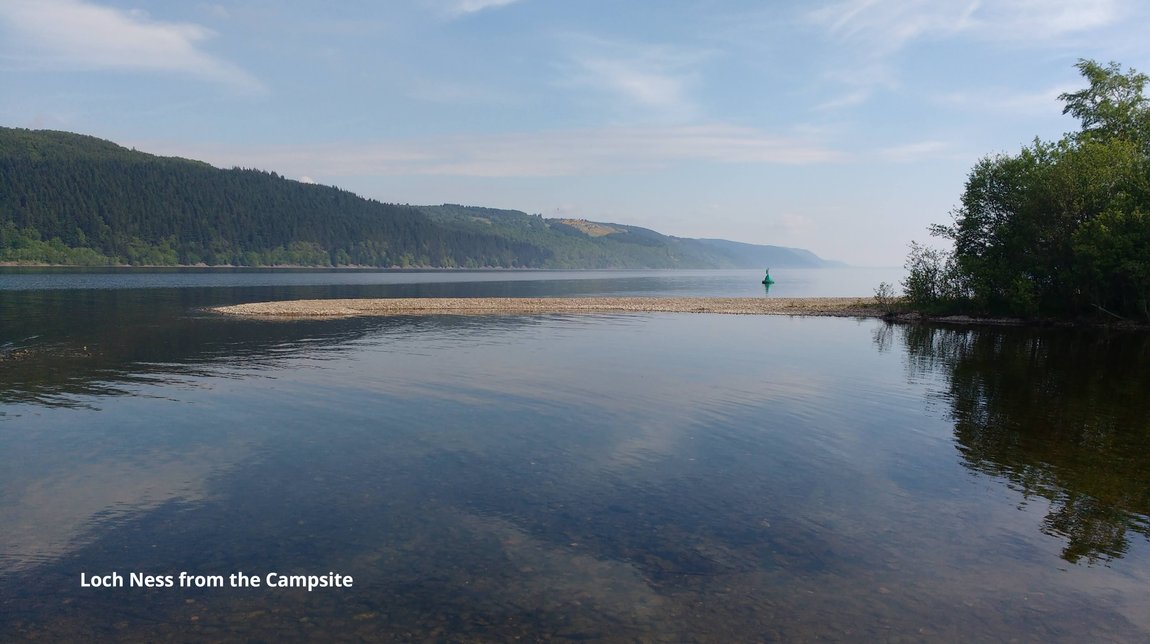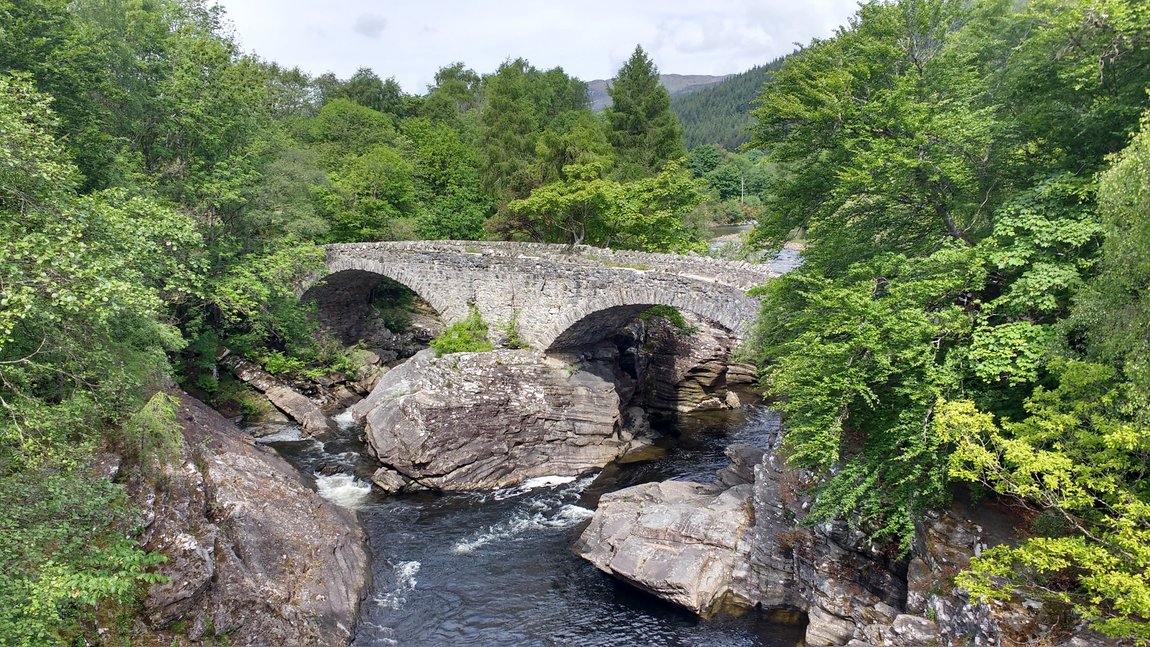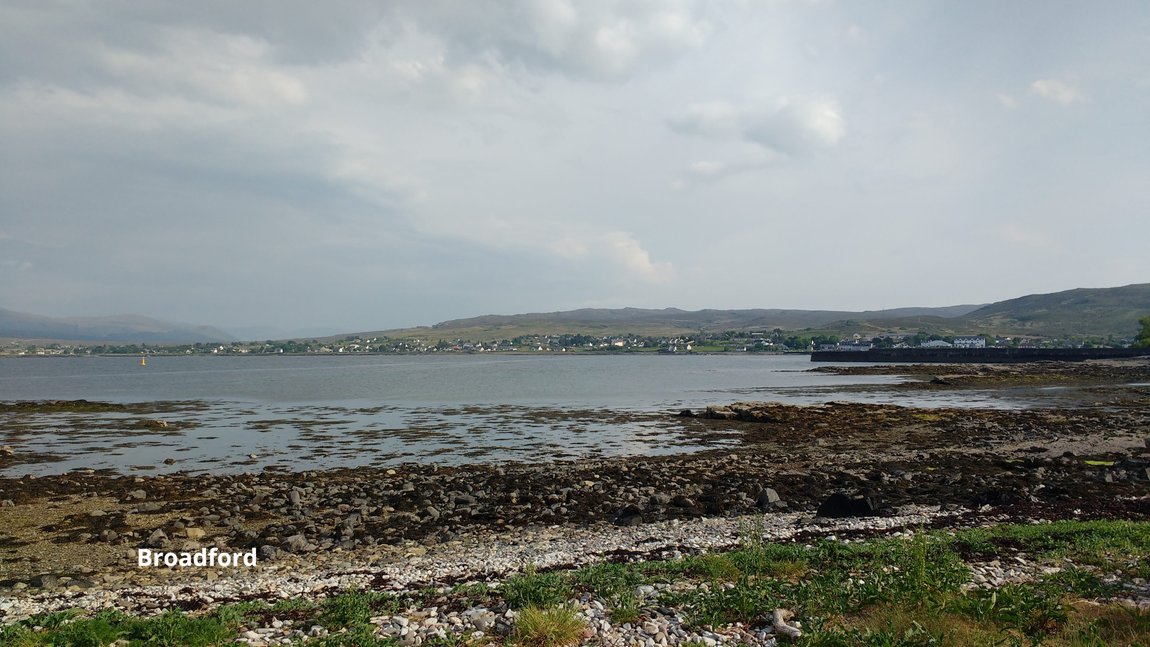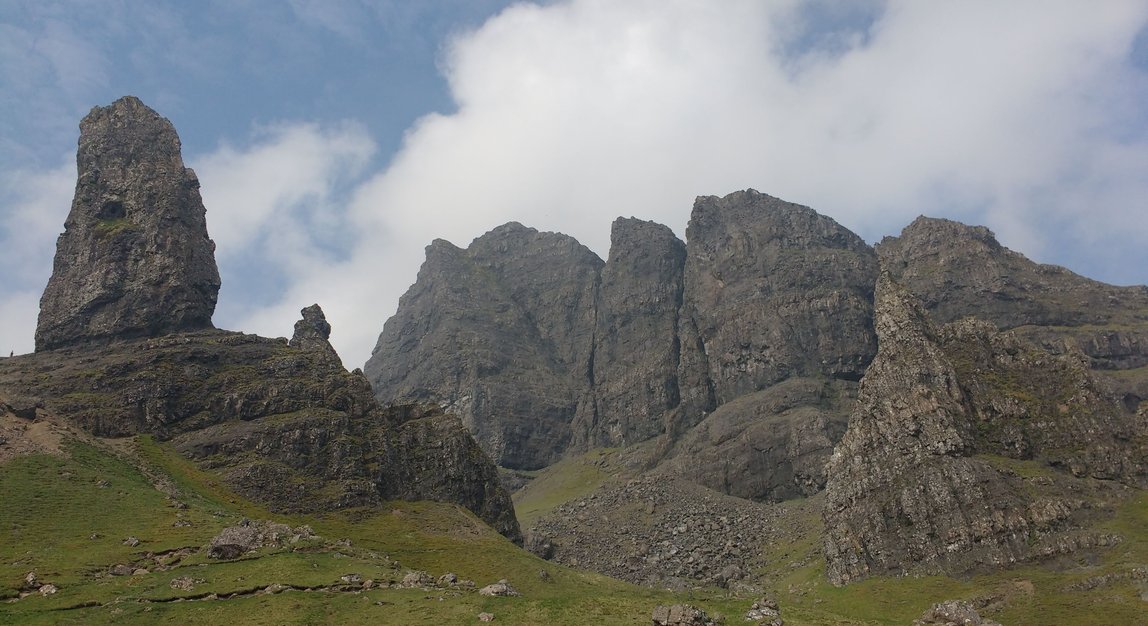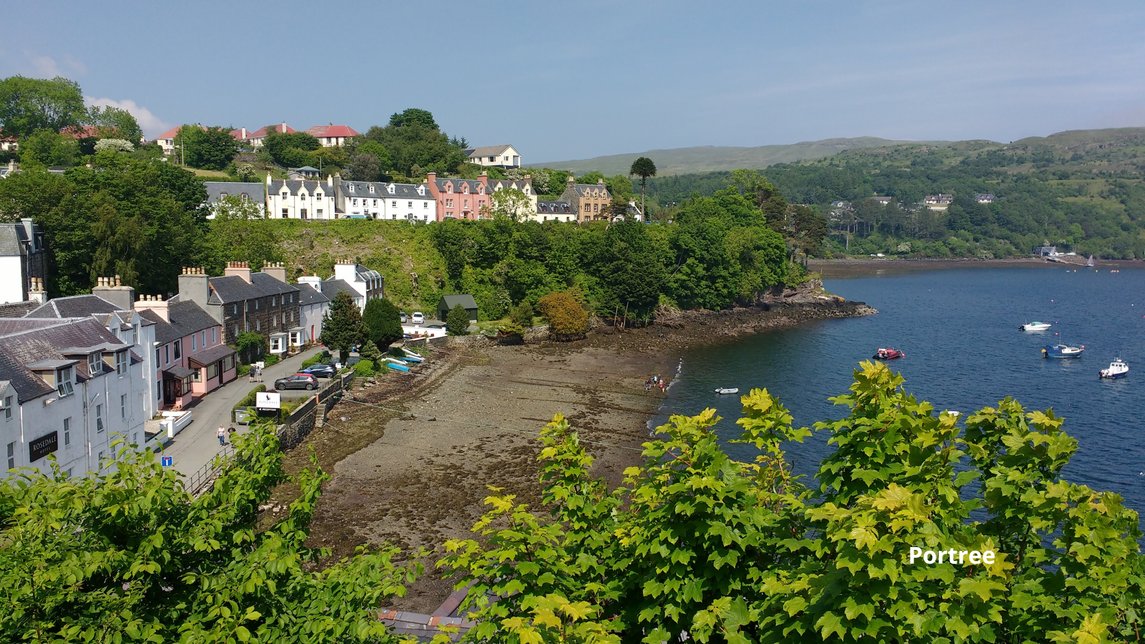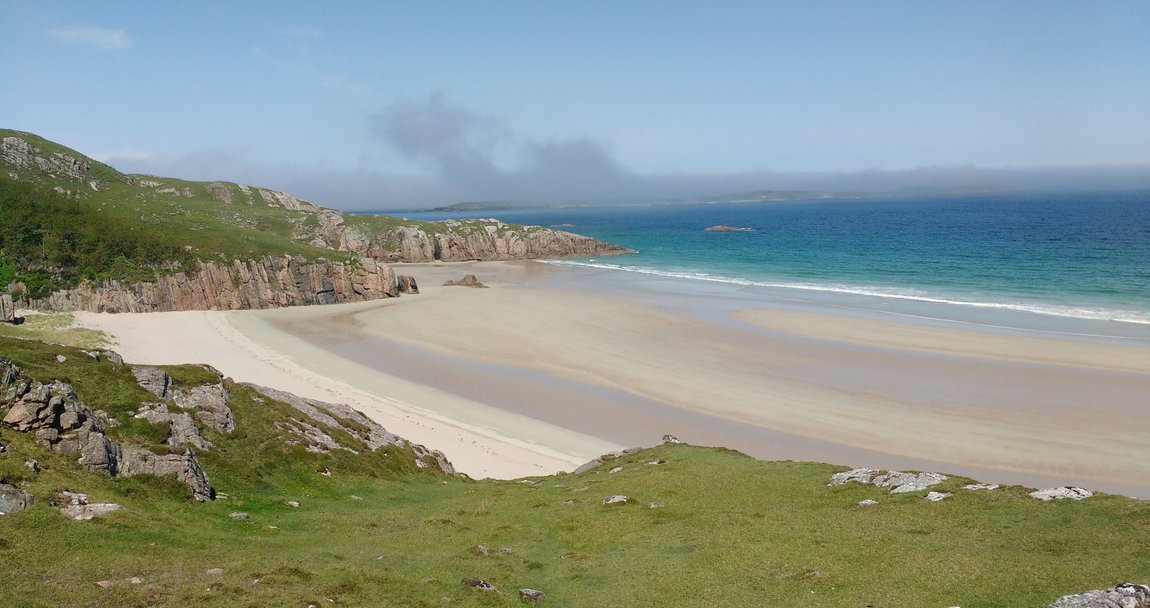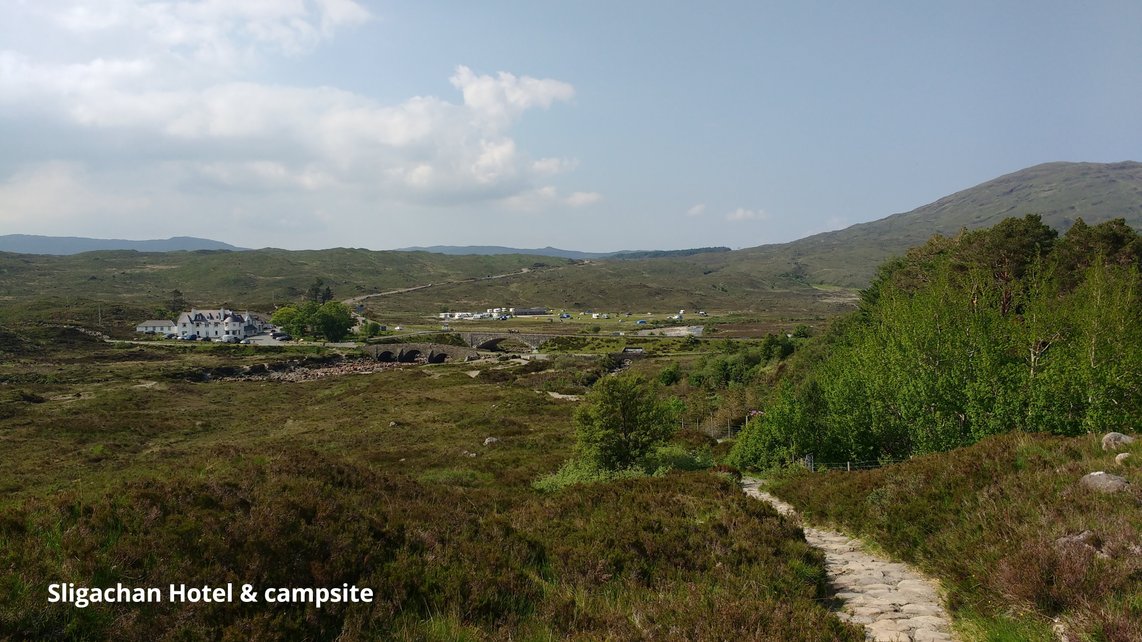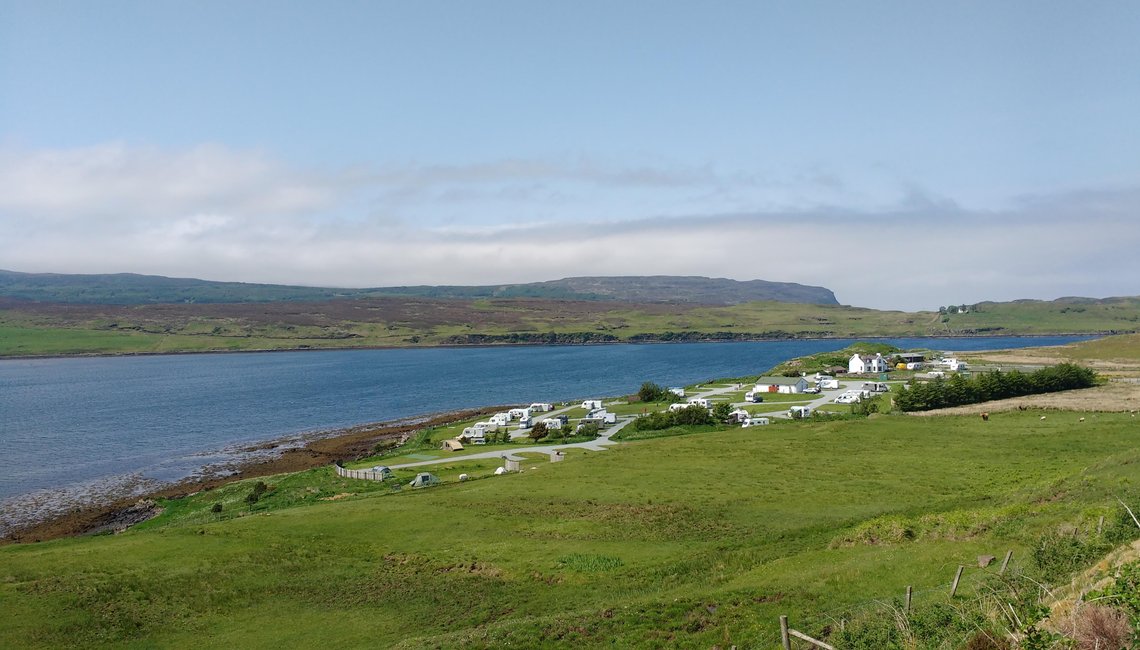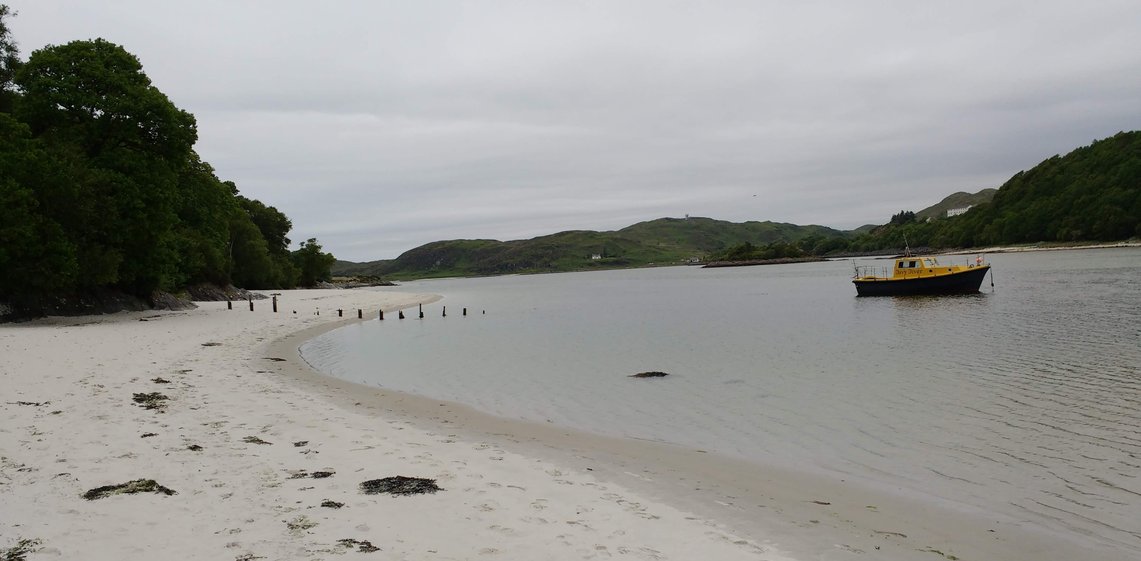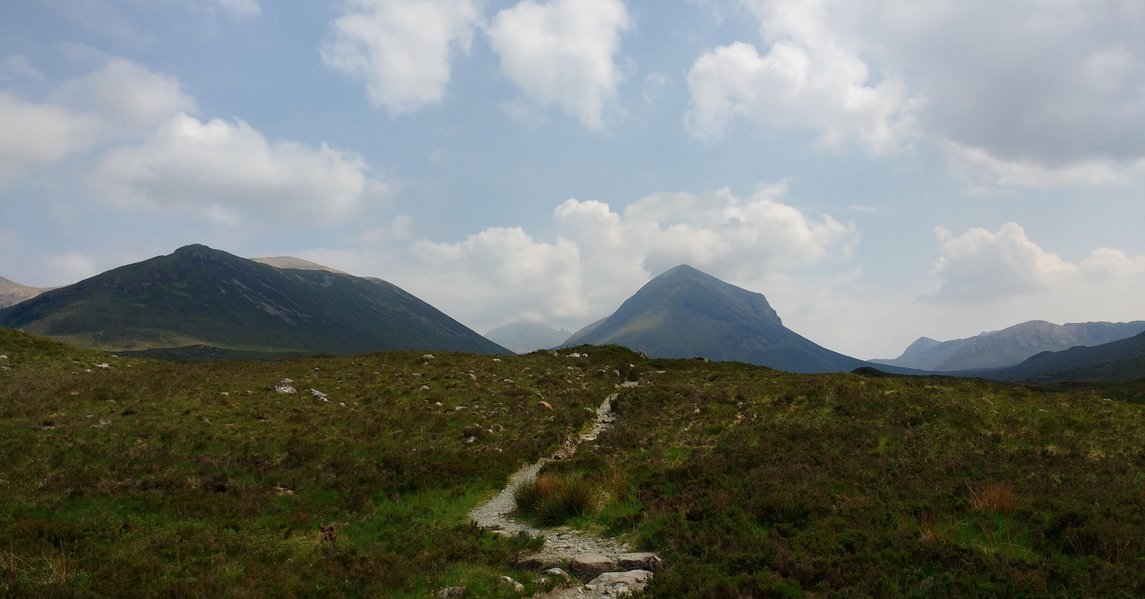Motorhometrips
with tips for cycling & hiking
Scotland North Coast 500
We had been putting off a road trip to Scotland for years, the scenery undoubtedly would be stunning but every time I glanced at weather forecasts for Scotland, it appeared that another depression was on its way, bringing wind and rain to the west coast. Also living in the south the lure of the continent, its equally stunning scenery and more benign weather meant that for over 40 years it proved unassailable compared with a trip northwards.
In 2018 we, however, bit the bullet and headed north but even at the eleventh hour the lure of Spain nearly won the day but no we said, Scotland had to be done. Little did we know, as the warm weather that we had been experiencing in the south turned to cloud and drizzle, as we headed northwards that the summer of 2018 was going to be outstanding. The plan of action was to go up the west coast, with a stopover in Southport on the way up, and then along the north coast from Cape Wrath to John O' Groats, with a stopover in the Orkneys, subject to weather, before heading down the east coast and then back home but as everyone knows motorhome trips never turn out quite as planned.
What we also were not completely planned for was that due to the popularity of the marketing of the Scottish 500, campsites along the route were often booked, so it was not just a case of turn up as you go, as per touring on the continent. We had pre-empted this to some degree by booking the sites within the vicinity of Glasgow on the premise that these would more likely be popular. This proved a good move as Culzean, Ayr and Loch Lommond were fully booked on our visits in early May. We lost count of how many units were turned away from the Loch Lommond site. On the other sites we booked as we went along and we were not always able to get our first choice. Also what was surprising is that sites were very busy over the Whitsun break, despite it not being a bank holiday in Scotland.
Scotland 500 Controversy
There is no doubt that the successful marketing of this route has caused some tensions in Scotland and the complaints revolve around motorhomers dumping black waste, (unforgivable) grey waste (less contentious but still avoidable) , not being able to drive particularly reversing, speeding and etiquette around parking in lay-bys and with regards to passing places and I have even seen comments regarding not spending in local shops but stocking up in the local Tesco's before the trip.
To deal with the issues in turn.
Black Waste Sadly there is anecdotal evidence that this happens. It is also a problem in New Zealand and with its proliferation of hired motorhomes, it begs the question what responsibility do the hirers have in educating their customers. It also raises the point of what additional investment have the Scottish authorities made in providing waste facilities. There has been a massive expansion of motorhome use in the 13 years that I have been doing it and if you market your country to attract motorhomes then you need to improve the facilities. You only have to look at the continent with its much superior facilities for motorhomers. Having said that there is no justification to dump your waste, so if you wild camp there has to be a time when you make the proper provision to dump your waste, by say visiting a campsite.
Driving I am not sure what you can do about this. The reality is that anyone can drive a motorhome up to 3.5 tonnes and it is different from a car, especially reversing. Again I suspect the culprits are the hired motorhomes. Having said that the hirers have to explain the etiquette around dealing with passing places. With regard to complaints about motorhomes occupying viewing lay-bys I am afraid this is just tough. The same applies when you can not park your car. Overnighting in laybys is a no no as is stopping in passing places.
Shopping Locally With regard to motorhomers just stocking up at Tesco's I think the complainants are being somewhat disingenuous. Do all Scots do their shopping at the local butcher, baker and candle stick maker. On our trip if there are local facilities which are accessible such as at Lochgilpead, which had a thriving shopping centre, within walking distance then we will use them. Or in the case of our trip to Altnaharra we stumbled across an excellent mobile fishmonger parked outside a small local shop but we also used Morrisons.
As for speeding, why on earth would you do it, the scenery is to be enjoyed, so if you should be doing anything then slow down, not forgetting to pull in if you have a car behind you and it does not take a genius to work out if it is a local trying to get to work or a fellow tourist, just soaking up the scenery like yourselves. I did have an impatient driver flash me on the road to Altnaharra but then I have also had the same on the M25 so tailgaters are everywhere.
Single track roads When a fellow motorhomer advised me that there were a proliferation of single track roads with passing places, one can not help feeling a little apprehensive. The reality is simple, there tends to be a lot of them and you can generally see well in advance and see what else is coming. There is also a golden rule, you can not fit more than one large vehicle in a passing place, so do not tailgate another motorhome, otherwise you will cause a jam and be very unpopular. In May and June we did not experience any problems and never had to reverse once and with a bit of foresight you can travel merrily on your way.
My advice, for what it is worth. if possible visit off peak. We visited in May and June and did not experience any issues but realistically some people do have to visit in July & August and the reality is that all across Europe it is busy. Also get out out of your motorhomes, walk,cycle or use public transport. The nature of the country is that parking of motorhomes is sometimes not going to be easy. It goes without saying, respect the environment, leave no waste or rubbish. Personally I do not see a problem with grey water but the perception is that other people do, so as a self respecting motorhomer, I do not just dump my greywater in the road and there are plenty of official places to use.
The other point I would make is to not consider the 500 as a rite of passage and the need to tick a box but use it as a guide to work out a great trip to this country, be flexible, you can always come back and don’t take your motorhome where it is clearly unsuitable to achieve some macho objective, for if it is a hired vehicle you will end up paying a large insurance excess and if it is your own, why run the risk of damaging your pride and joy. Finally listen to the locals.
Prepare for the unexpected this is the A838 near Tongue. This did not, however, prevent a car from overtaking me, and nearly taking out the farmer’s dog.
Southport
This was chosen simply because we had never been there before, that it had a reputation as being a very pleasant chic Victorian resort and that it was as far as you would want to tackle on the M6 on the way northwards.
The town does have a certain elegance to it and you can see why this resort thrived in the Victorian era and this continues to this day, though perhaps spoilt by the proliferation of arcades in the modern era. Additionally the amount of traffic that thunders through the high street somewhat detracts from the image of a genteel seaside resort.
Firstly we had a great journey up, no hold ups and we didn’t even have to spend more money on the M6 toll road. We stayed at the Caravan Club site, situated just outside of town and within easy walking distance of the town centre and ideally placed for coastal walks, being within a stone’s throw of the beaches, which have a certain feel of austerity to them, not wide sweeping bays with glistening sand, more wild and windswept, with coastal marsh and sand dunes backing them up.
There is an aire by the amusement park.
There are,however,some great walks and a big plus is a rail route which runs from Southport, initially following the coast, before heading into Liverpool and this allows a great variety of walks, getting on and off from different stations. Another great alternative is to cycle and Merseyrail positively encourages you to take your bike on the train and this appeared a very popular choice. The town publicises a number of short cycle rides around the area and leaflets can be picked up at the tourist centres and it is also the start of the Trans Pennine Cycle Route
We chose to take the train to Hall Road and then a short walk to the beaches at North Crosby and to the Antony Gormley's 'iron men ' sculptures. We then walked along the beach cycle walking route to Marine Lake and had a very acceptable lunch in the Adventure Centre.
On a whim we then decided to get a bus into Liverpool as we had never visited the city before and the plan was to get the bus 47 into the city but arriving at the bus stop, there were a number of buses going into the centre, we took bus 300. The bus stop is on the main road, about 10 minutes from the Adventure Centre and they run regularly and the journey is only about half an hour. Ok you can not do a city the size of Liverpool justice in half a day but nevertheless you can have good fun exploring the main sites.
We returned via train from Central Station, buying single tickets to Hall Road.
Creetown
Crossing the border at Gretna Green, we took the A75 and stopped at Creetown, on the basis that it looked at attractive stopover and it was far enough to drive in a day, and with the afternoon developing into a very sunny day, it was time to get out and walk. We took cycle route 7 in the direction of Newton Stewart, which follows the road out of town before deviating onto the old railway and a very pleasant walk, overlooking the Cree valley. Cycle route 7 runs from Newton Stewart via Creetown to Gatehouse of Fleet., part of a longer route linking Sunderland to Inverness.
We stayed at Creetown Holiday Park, right in the centre of the town and we could not have received a warmer welcome from Lindsey. This is primarily a static park and the likelihood in the near future is that sadly there will be limited opportunity for tourers, as they site more static units.
Culzean Castle
There is a song which goes along the lines of ‘you take the low road & I will take the high road', so modifying that, we took the slow road from Creetown to Culzean Castle and followed the Galloway & Ayrshire coast as much as we could by taking the A714 to Monreith, before picking up the A75 and then A77 from Stranrear and the Ayrshire coast into Culzean, coffee & lunch breaks on the way.
Culzean Castle is a Camping and Caravan Club site next to the Scottish National Trust property of the same name. There are extensive grounds which have a whole variety of flora and fauna together with an 18th century castle, imposingly positioned on the coastal cliffs. In all our travels one of the most satisfying observations is when plants and trees are in full bloom, whereas at home they may be dormant. So Scotland had the advantage of being a few weeks behind as far as spring was concerned, so all the spring flowers of tulips, bluebells, wild garlic and wood anemone were in their full glory, whereas back home they were past their best, so to experience two springs was a big plus.
A visit to the castle is a must and we had a very entertaining guide, Gordon, who was not only very informative but also witty. The lunch at the 'Farm' was also good quality.
You could easily spend an afternoon walking the grounds and the coastal walks either side of the castle are awesome. We did the walk to the small port of Maidens, which has now been taken over by the locals and found a small shop where you can get tea and cakes.
There is an hourly bus service, which stops outside of the site so making a one way walk from both Ayr in one direction and Girvan in the other direction possible.
Ayr
We chose to move just up the road to the Caravan Club site at Craigie Gardens for our continued exploration of the Ayrshire coast. As it was a weekend, this site was fully booked.
Ayr is not a particularly attractive town. It has a number of historical connections with Robert the Bruce, Robbie Burns and it was a fortress town in the English Civil War. The port obviously played a significant part in the town’s economy.
What is attractive is its beaches, it’s main beach from the port to the Heads of Ayr is awesome. You can easily walk from the site to the beach or in our case we cycled, picking up cycle route 7, which we followed past the ruins of Greenan Castle, into the country.
In the other direction, cycle route 7 takes you to Troon and Irvine, passing Prestwick Airport on the way as well as the golf courses of Prestwick, home to the British Open golf tournament and Troon. In this part of the world you will not go very far without coming across a golf course.
The cycle route to Troon takes you through residential areas and the coast, as well as by passing the airport but this is no Heathrow and I do not think we witnessed an aircraft taking off or landing. On all the main roads you are cycling on designated cycle paths and the ride to Troon is not an unpleasant ride and the arrival into the main beach area is well worth the ride.
We continued onto Irvine and this was not the most enjoyable part of the ride. The first part of the ride is quite pleasant as you leave Troon and follow the coast but you are soon diverted into residential areas and then you follow the main road into Irvine, albeit on a separate cycle way, it is noisy. Divert to the beach and you will not be disappointed, Irvine Bay is awesome.. We decided to take the beach back to pick up the cycle route just outside of Troon. We checked the tides and high tide was not due until gone well past midnight. The walk along the beach is about 2 miles and in places the sand was too soft to comfortably ride but it was no hardship to walk this glorious beach.
The total return trip was about 33 miles and I would guess that we had saved about 3 miles by taking the beach.
The cycle route 7 is superbly signposted
Ayr being a large town is a god place to stock up on supplies,it has a good selection of shops in the town and a Morrisons on the outskirts, which also has cheaper diesel.
Loch Lomond
From Ayr we had the choice of taking the direct route, A737 or the A78 coastal road with an additional side detour on the A770 via Gourock, no contest, coastal route it was.
We stayed on the west side at the Camping and Caravanning site at Luss, as we wanted to cycle the West Long Cycle Route. Luss is approximately midway, 8 miles north to Tarbet and 9 miles south to Balloch so an easy cycle in the morning one way and lunch and then in the other direction in the afternoon.
This site was extremely busy and the warden turned down a countless number of on spec visitors and bear in mind that in Loch Lomond, no free camping is allowed.
There is another C & CC site on the other side of the loch and this is better if you want a chance of seeing the osprey.
The cycle ride north to Tarbet is the more interesting as it hugs the loch though the downside is that it also very affectionate with the A82 so it is difficult to escape the hum of the traffic. There are sections where the path drops below the A82 so at least it is only one not all of your senses that is aware of the road but the views are glorious. Roughly half way part of the ride opens up into a greenway as you follow the old road and there are brief moments when all you will hear is birdsong. At the end of the old road you join the A82 and are effectively cycling along the pavement and this is the least pleasant part but you soon reach a large greenspace overlooking the loch and there is a small cafe (Ben & Bonnie cafe) and toilets. The alternative is to continue to the road junction and turn left onto the Fort William road and there is another cafe immediately opposite but the views from the first one makes this first choice.
Southwards to Balloch is less scenic in our view as you lose sight of the loch for large sections of the cycle. You take the minor road out of Luss and though this is on the road, it is very quiet. For this section you do follow the loch to Aldochlay and then you take a small up and down wooded section before picking up the A82 and there is not much fun about this section. You can, however, divert through the golf club and this is signposted as the 'Loch Lomond Cycleway' and this is a lot more pleasant. You, however, soon pick up the A82 again but as you approach Duck Bay you take a minor road which is a welcome stop before you go on to Balloch. There is a hotel in Duck Bay which provided welcome, if somewhat expensive refreshments and to add insult to injury, they served it in plastic glasses but it is a very pleasant lochside view.
If staying in Luss it is quite a good idea to get an aerial view of the loch for a different perspective. We took the 'Fairy Walk' from the church, which starts with a river walk and then a quarry walk which then leads on to a hill path and after a short climb, you get good views of the loch. We were not sure if the fairy walk was a private walk, there is reference to paying in the shop but we concluded that this was for the booklet, which comes with the walk and the interpretation of fairy statues and regalia, the latter were not too intrusive.
Luss is very geared up to the tourist trade, catering for the coachloads of tourists that call in. There is a small general stall and an unmanned petrol station. There is the Luss Smokehouse shop, where we obtained some excellent smoked trout and a good pub, the Loch Lomond Arms.
The Luss site is a very attractive lochside site with hardstandings and grass pitches but as the site is prone to flooding, the grass pitches can easily be put out of service. It is not too difficult to pick up a pitch with a loch view and it is in easy walking distance to the village of Luss. The cycleway passes right next to the site. There is no motorhome service point and the facilities are somewhat dated but perfectly adequate.
Lochgilphead
This site was chosen as it provided convenient access to the Crinan Canal as you literally turn out of the campsite, onto the main road and turn right and in five minutes you reach the canal. The canal runs from Ardrishaig, about a mile and a half to the west and Crinan, about 8 miles to the east. There is a cafe at Ardrishaig but it is on the main road.
The canal opened in 1801 and was designed for shipping to avoid the notorious waters of the Mull of Kintyre. The canal was designed by John Rennie and Thomas Telford and James Watt were involved in its construction. In the early days the canal was beset with technical problems and Thomas Telford was brought in to improve its performance. It is certainly a feat of Victorian engineering and a joy to ride. There is a great little cafe at the Crinan end in a delightful setting overlooking the canal basin. Additionally at the hotel there is a superb seafood restaurant.
A short ride will take you to Crinan harbour.
We were lucky enough to see a Clyde Puffer at Crinan, these little coal fired steamer cargo ships were once a common site on the west coast, providing a vital supply link with the mainland and the Hebrides. Today it is possible to take a holiday on one of these remaining ships.
We took a detour to the Beaver reserve at Knapdale, making a 30 mile cycle ride in total. You can cycle around the smaller loch and there is a beaver lodge here and evidence of cut down trees.
We took the Beaver walk and the section around the larger loch is not suitable for cycling and we had to push our bikes around the track and this did involve quite a lot of effort as the track is uneven, with quite a lot of ups and downs but it was well worth it. Though we saw evidence of beavers, tracks and lodges we did not actually see any beavers. As they are basically nocturnal and shy animals, your only hope of spotting any is to be very patient and silent and visit at dusk or dawn.
We stayed at Lochgilphead Caravan Park which is a mixture of statics and tourers and fully serviced pitches are available. We liked this site, we found them friendly and very laid back, pitch up and sort out later, which is a refreshing change from club sites. The facilities at the site are somewhat dated but they were perfectly adequate. There is a motorhome service point.
Lochgilphead is a good base to replenish supplies. There is a good co op as well as a superb fishmonger. You will also find the proverbial butcher and baker and good cafes. This was a great stopover.
Oban
We took the A816 to Oban and the plan was to use the Camping & Caravan Club site at Barcaldine, north of Oban as we wanted to cycle the route 78, which for this section, follows for a reasonable part of its journey, an old railway line and this site was closer to what I thought was the more interesting part of the route, judging by the Ordance Survey map.
The Camping & Caravan Club site, however, was fully booked so we chose to stay at the North Ledaig site, which is an affiliated site of the Caravan Club and this turned out to be an inspired choice as it had excellent sea loch views and the facilities were good and they provided two motorhome service points. Admittedly we had to cycle a little bit further but a big plus was the old railway line goes straight through the site and though it is not an official section of route 78, it can be used in both directions to pick up the 78 cycle route.
North Ledaig is a huge site and appears to have a mixture of permanently sited caravans and tourers but despite its size it appeared spacious and because it was not main season, it did not feel overbusy. Its power supply is limited to 10amps, which did appear to cause some of the caravanners problems but as most of our stuff is geared for continental touring, this proved to be non problematic.
We cycled past the Barcaldine site and it was pleasant enough but without any loch views and in a walled garden, you could have been anywhere. We continued to Creagan Bridge, where there is still evidence of the station, together with platforms, though this is now a private residence. There is the Creagan Inn, which is a good refreshment stop, with views overlooking Loch Creran. We continued onto Stalkers Castle near Port Appin, taking the circular loop at Appin, which is well signposted and the total bike ride was about 27 miles.
The next day the weather changed and though not heavy rain, there was constant light rain, drizzle for most of the day. We decided to take the bus 410 into Oban, which stops right outside of the site and explore Oban. It is a pleasant enough town and certainly looked much better in the brilliant sunshine when we arrived. It is home to the Oban Distillery, which you can tour and it is a busy ferry port but in reality it is not very big. It has its own mini colosseum, which is worth a visit.Its name is McGaig’s Tower, built by a wealthy banker, John Stuart McGaig as a memorial to his own family but also as a philanthropic gesture in providing work for the local stonemasons in the winter. It is a bit of a climb but the views are well worth it.
It also has a very busy seafood stall, by the railway station which judging by the number of people patronising it, on a very miserable day must be testament to its quality. We were not tempted, eating seafood outside, no matter how good, on a damp miserable day was not very appealing.
In the evening, the rain had abatted so we walked along the railway path and route 78 to the bridge at Connel, which crosses Loch Elive. It is possible to cycle to Oban but the cycle way does follow the main road for a way, before cutting into minor roads, before coming into Oban.
Glencoe
We decided to move from North Ledaig the next day, as the weather was still inclement, to Glencoe. The original plan was to go to Fort William but the two activities planned would not have been much fun in poor weather and in fact one of them, climbing Ben Nevis, would have been a non starter. So the idea was to get a change of scenery, though with the mist and rain, this was not a practical solution. The drive along Loch Creran and Linhe was, however, pleasant enough.
We stayed in the Camping & Caravan Club site at Glencoe, which is situated in forestry commission land and is right next door to the Glencoe Visitor Centre. It is a very picturesque setting, surrounded by hills and at the site of the Glencoe massacre and there is a pleasant walk from the centre, not very long and with an extension to the village, which was just about right for a drizzly day. We left the visitor centre exhibition to the following morning and combined this with the same walk but now at least we were able to get better views of the mountains and the loch.
The Folk Museum, housed in traditional thatched 18th century cottages is well worth a visit nad there is lots of interesting materaial, including articles dating back to the Glencoe massacre
The warden at the site was extremely helpful in providing gaffer tape and step ladders as we had sprung a leak over the window which became evident in the rain at Oban. A temporary repair which proved adequate, though ironically it was never tested, as after Glencoe we did not have any rain.
The site does have a motorhome service point.
Glencoe is fairly limited re facilities, a garage with a convenience store and that is really your lot. There are also a couple of cafés.
Fort William
The decision to delay arriving at Fort William by a day was truly inspired for thereafter we had spectacular weather. Fort William Is very much one of the centres of the Highlands and is a very popular resort and as such has all the facilities you need for a restock, with a large Morrison’s and Lidl situated near the bus garage. Lidl is normally easier to park in than Morrison’s though the latter has a petrol station and it is a good idea to refuel here as the further north you go the more expensive fuel becomes, resembling motorway prices.
It looks like you can overnight in the car park near Lidl.
We stayed in the Glen Nevis Campsite, a very pleasant setting below the Nevis range and with all the facilities you would expect of a premium site but also at premium prices, though to be fair, off-peak you get 4 nights for the price of 3 and if you book a premium pitch with water and drainage, this only costs an extra £1. There is a motorhome home service point. The shower facilities etc are perfectly adequate but may struggle at peak periods though I get the impression that this is a rapid turnover site. Certainly off peak there were pitches readily available.
The big attraction of this site, is that it is within a 15 minute walk of the Visitor Centre and the start of the Ben Nevis walk.
We were very fortunate in that we had a perfect day for the climb, pleasantly warm and towards the end of the day verging on hot but more importantly clear and given that on average only 1 day in 6 is clear we were very blessed.
On a day of very benign conditions it does seem that the world and his wife climb Ben Nevis and following the tourist track, this is not a particularly technically difficult walk, nor is it very steep though it is reasonably long. It took us just over 3 hours to climb it and a similar time to descend, though in theory it should be much quicker on the descent.
When reading the advice on climbing Ben Nevis, it is full of warnings and on a clear benign day you wonder what all the concerns are about. The only comment I would make is that for a brief period a mist came down and it is absolutely true that this can be extremely disorientating and on the final ascent there is not a great deal of room for error, as there are sheer drops on the left hand side. If you had a sudden fog or driving rain or worst still snow, you would have to really rely on compass bearings and know what you are doing. Additionally there is snow at the top and towards the edge there may not be anything firm below this snow. There are a series of cairns which we hugged quite closely, we have too much respect for mountains, where the weather can change without any notice. We were still surprised to see tourists perilously close to the edge as they walked over the snow.
So in conclusion I would conclude that on a fine summer's day this is not a difficult climb and there is little danger of getting lost as you follow the crowds up the mountain. In more challenging conditions it is a different ball game. People die on this mountain, even in May.
The Ben Nevis Inn at the bottom is a welcome respite after a long day and it would be rude not to visit and enjoy a beer and some convivial conversation.
The other site that we wanted to see was the Caledonian Canal, that testament to Victorian engineering and to an industrial revolution hero of mine, Thomas Telford. The canal navigates the west coast from Fort William to the east coast at Inverness, connecting the lochs in the Great Glen. Having already seen the canal at Inverness I wanted to see the other end and it was a relative easy cycle ride from the campsite to the town and then follow cycle route 7 to the canal. In total we did about 30 miles which included the sea locks at Corpach , the series of locks called the Neptune Staircase and a ride towards Gairlochy. As an added bonus the cycle route in the town includes a trip to the ruins of Inverlochy Castle.
Ardelve
This is a lochside campsite and it appears to be just turn up and pitch and if you get there early then you will have a lochside pitch, though these tend to give you less room. The site fee is £15 a night, cash only and the owner collects in the evening. Electricity is paid for with a £2 coin and showers are 50p. The toilet facilities are basic but spotlessly clean. This was one of our favourite sites, gloriously laid back and in a brilliant position.
The main attraction was Eilean Donan Castle with its romantic setting in the loch, connected to the mainland by a bridge. OK it is a tourist honeypot and it has been rebuilt with probably a fair degree of licence re historical accuracy but it is well worth a visit.
It dates back to the 13th century but the modern castle bears tentative resemblance to the original. The castle is the ancestral home of the Mackenzie clan and their allies Clan Macrae. The clans were on the losing side in the Jacobite rebellions and the castle was destroyed by the Royal Navy. The present reconstruction was the result of Lieutenant Macrae Gilstraps effort, who rebuilt it as a family home.
The advantage of staying at Ardelve is that you can revisit the castle when all the crowds have gone. It is not possible to go inside after hours but it was great to have the outside virtually to yourselves.
There are not really any facilities at Ardelve. There is a cafe in the castle and another up the road on the left. Additionally somewhat bizarrely, when you turn left there is an artisan baker operating from his house, offering a limited but quality range, more in keeping with Islington than a small Highland village. He also has a pizzeria as well.
Inverewe Poolewe
We stayed at the Camping & Caravan Club site and as it was Whitsun Bank Holiday (though not a Scottish holiday) sites were getting busy and also we needed a chill out, so we phoned a couple days in advance & booked 3 nights. The premium prices of bank holiday's came as a shock to the system and at nearly £30 a night we considered this exorbitant, for though the site is in a great location, the facilities are dated and only just adequate. The other thing that surprises me about Camp & Caravan sites is the lack of real investment for motorhome users. The motorhome service point was a manhole cover and there was a filling point next to it but why not convert this to a dedicated motorhome service point, hardly an expensive outlay. Also the camp commandant presented all that could be possibly wrong, yes he was incredibly efficient but no warm welcome. Also there was no way you were going to get into this site before 1.00pm, rules are rules. The caravanners before us, Eric and Doreen, arrived half an hour early and Doreen is disabled but no way were they going to get in. What was absurd is that access to the site is limited, so by the time we arrived at 1.00pm there were two units waiting to get in plus Eric & Doreen, who were made to wait, blocking the entrance, so by 1.00 there was a caravan waiting in the road, which could have been easily avoided by a more pragmatic approach.
The Inverewe Gardens are worth a visit and you can easily spend a good half day here. It is run by the Scottish National Trust so our NT cards covered entry. They are amazing given their relatively remote location. The staff are very helpful in giving you an insight into the history of the building but undoubtedly the main attraction are the gardens and it is possible to stay after closing up to 9.00 pm. There Is a cafe in the car parking area serving the normal National Trust fare.
If you ask nicely Inverewe Gardens might let you overnight on their car park if you are stuck.
Circular Walk from the Site
A superb walk from the site is on offer through part of the Inverewe Estate. It is a circular walk of about 11 km and the entrances to the walk are signposted, one to the left of the site and the other to the right.
The one to the left follows the road along the river until you join a gravel track which leads to Inverewe house. Now this is a spectacular walk but it gets impressively better when you pass the house and the track becomes a moorland/mountain track, not difficult but not the steady strolling experienced on the first part of the walk. In hindsight it would have been better tackling this walk in the other direction, firstly because this is the more difficult part of the walk and it would perhaps be a good idea to get this done when you are feeling fresh but more importantly you are walking towards the more spectacular views. Nevertheless it was no hardship to just stop and stare following the recommendation of W H Davies. ' What is this world if full of care, there is no time to stop and stare' or something similar.
The walk should have taken under 3 hours but five hours later we had finished as a result of meeting some very interesting people with discussions ranging from the merits of Scottish independence, the challenges of climbing the Munro’s to the pros and cons of spinner fishing vis a vis fly fishing.
Cycle Ride Rubha nan Sassan
The final day was devoted to a cycle ride along Loch Ewe towards Cove Rubha nan Sassan to learn a little more of the history of the loch in World War Two. In this conflict the loch was used as an assembly point for the Arctic Convoys that provided relief supplies to the Russians confronting very dangerous hostile conditions en route. The loch was ideal as it was sheltered, defendable from U boat attacks and remote enough to be at the full extent of the range of German aircraft. The whole area was sealed off and strictly controlled. It was extremely interesting as this hidden history was completely new to us. A poignant reminder of the horrors of war was provided by one ship, which went aground approaching the loch with considerable loss of live and also illustrating the courage of local inhabitants who tried to facilitate rescue bids, crossing hostile moorland in atrocious weather to help any survivors.
On the road up there is a pleasant, no facilities site, overlooking the loch but for us Inverewe proved to be more central, if, however, expensive.
There is a birdhide on the loch, just to the right of the campsite, which is a good observation post for sea birds and otters if you are lucky, early morning and dusk are the best times to see otters.
Scourie
The drive from Inverewe to Scourie is drop dead gorgeous, on every turn you are confronted with another stunning view. Our first pit stop was Little Gruinard Beach on the A832.
We then continued on the A835 onto Ullapool for lunch with prior knowledge that there was an excellent fish and chip shop. It is surprising what tips you pick up from your fellow travellers and we had been told that the chippie was one of the best and though a very unassuming place, we were not disappointed and there is nothing to beat eating a fish and chips outside in glorious weather. The fish was cooked fresh from scratch and with convivial conversation with other customers as we waited, it was no hardship. I know it is an old cliche that the further north you go people have more time for you but how true it is, everyone we met in Scotland were friendly and prepared to exchange the time of day with us. Ullapool is an attractive port and there is a good campsite right on the Loch and as is everywhere in Scotland it was easy to get in and park. It also has a Tesco if you want to stock up and a number of local shops, though most are geared to the tourism.
There are two superb lochside campsites in the vicinity, the first in Ullapool itself.
A short way up, out of town on the A835, there is another gorgeous lochside site, Ardmair.
We were very tempted not to leave Ullapool but leave we did, to pick up the A837 northwards and another stunning castle, Ardvrek Castle on the Loch Assynt. It is a ruin but in many ways as interesting as Eilean Donan Castle. It certainly necessitated a stop and at this time of the year parking was easy.
This is not a drive to be rushed and we repeat what was said in the introduction, the 500 should not be treated as a rite of passage, a route to tick off but we appreciate that not everyone has the luxury that we have in taking a leisurely trip.
Scourie campsite is how a campsite should be run. It was set up by the present owners granddad, who apparently ran the site with a rod of iron. Thankfully his grand daughters are now much more relaxed and what you have is a very reasonably priced campsite in a stunning location with great facilities and a very warm and friendly welcome. We had a superb pitch directly overlooking the sea.
There is a bar/restaurant which does fairly basic food. The hotel is a short walk away and also will do food.
Eiders and divers can be seen from the campsite but the otters eluded us again.
When I asked about getting to Handa Island Wildlife Reserve, they offered to provide a taxi service to the ferry at a very reasonable price of £5 return. Ok we had to fit it around the school run but this was no hardship and on the return journey, though we had to wait a wee while, the cafe at the ferry offered welcome respite. Everything in this part of Scotland is fairly laid back.
The ferryman was the father of the girls that ran the site; I think everything is a family affair here. You can drive to the ferry but parking is limited and honestly it saved a lot of hassle and we were delighted to be the guinea pigs for this new service, one we would recommend to continue. The ferry operates on a turn up and go basis, so you may have to wait for the ferry to return but it is only a very short journey.
Handa Island is privately owned but managed by the Scottish Wildlife Trust and the rangers were extremely helpful.
The wild life is amazing: puffins, guillemots, fulmars, razorbills and kittiwakes are to be found on the cliffs with Arctic Skuas and their bigger bullying cousins Great Skuas or locally known as bonxies are in abundance with their spectacular aerial displays. Red grouse can be seen on the moorlands.
We had a great day birding and though for most it seemed the clowns of the sea, puffins, were the major attraction, for us the Skuas were top of the bill. What was interesting was the number of keen photographers, with their heavy equipment and the lengths that they would go for a perfect picture, as they encroached dangerously onto the cliff edges. Some of them definitely appeared to have a death wish.
Altnaharra
The plan was to stay at Durness and get the ferry to Cape Wrath but when we arrived the town was blanketed in a thick sea mist and the weather forecast for the next day was more of the same, so a change of plan was in order. We had met a fellow motorhomer at Ardelve, who had told us that after Bettyhill the route gets less interesting and the routes inland were good fun. So we rang the Caravan Club site at Altnaharra and fortunately they had one vacancy so that was our next port of call.
The drive to Tongue was fantastic and we were soon in sunshine again. After Tongue we found a small store with its solitary pump to top up with diesel and even better there was a fresh fish van at the store, dinner sorted. The laid back attitude of the store was symptomatic of our trip to this part of the world, everything is delightfully unhurried. This was exemplified by us having to stop before Tongue on the main road to let a flock of sheep past, though some impatient driver went past me, unaware that the reason I hadn’t moved was that the sheepdog was still to pass. I think if the car driver had hit the dog, he would not have been very popular.
